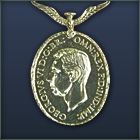The Distinguished Flying Medal
The Distinguished Flying Medal Origin and History

The Distinguished Flying Medal (DFM) was founded in 1918 by King George V at the formation of the Royal Air Force (RAF). The Distinguished Flying Medal was to be awarded to non-commissioned officers and enlisted men for an act or acts of valour, courage, or devotion to duty performed whilst flying in active operations against the enemy. The DFM was later extended, during the Second World War, to the Air Arms of the Army and Navy.
A straight slip-on silver bar was awarded for a further act or acts that would have warranted the medal. The slip-on bar has an eagle in the centre and the year of the award engraved on the reverse.
The medal is an oval silver medal that is 1.375 inches wide and 1.625 inches long. On the front of the medal was featured the head of the reigning monarch at the time, facing to the left.
The reverse of the medal features Athena Nike, one of the Greek Goddesses of Victory, seated in an airplane with a hawk rising from her right arm. Below her right arm are the words “For Courage”.
The medal is linked to a bomb, which is attached to the clasp and ribbon by two wings. The ribbon is 1.25 inches wide, and consists of alternating violet and white stripes (0.0625 inches wide) leaning to the left at 45 degrees from the vertical. The violet colour is to appear in the bottom left and upper right corners when viewed on the wearer’s chest; until 1919, the stripes were horizontal.
In total, 556 Distinguished Flying Medals have been awarded to Canadians, plus 136 to RAF/RNZAF/RAAF Personnel serving in RCAF Squadrons (see below).
Summary of Canadians Awarded the Distinguished Flying Medal
| RCAF | Serving in RAF | Serving in RCAF | |||
| Medal | Bar | Medal | Bar | Medal | |
| WWI | 0 | 0 | 1 | 0 | 0 |
| WWII | 516 | 0 | 39 | 0 | 136 |
| Korea | 0 | 0 | 0 | 0 | 0 |










